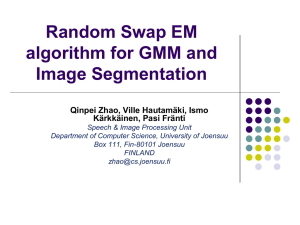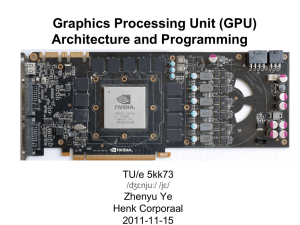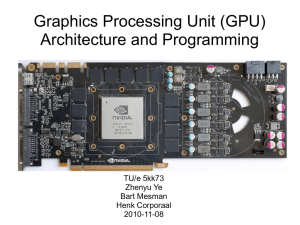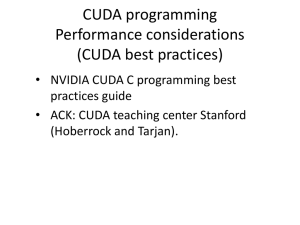Graphics Processing Unit
advertisement
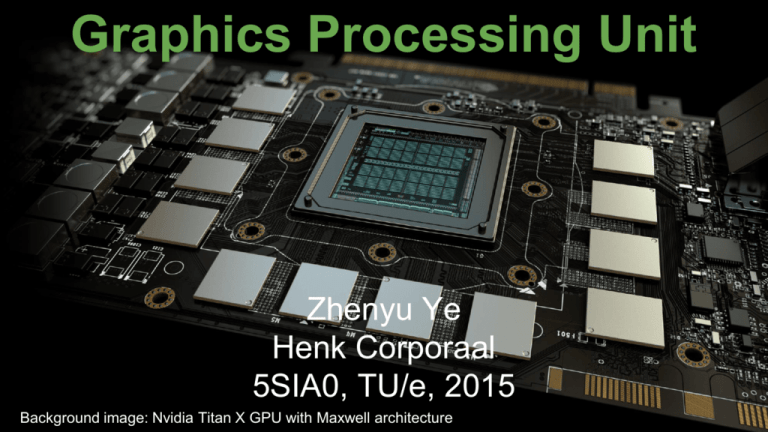
Graphics Processing Unit
Zhenyu Ye
Henk Corporaal
5SIA0, TU/e, 2015
Background image: Nvidia Titan X GPU with Maxwell architecture
The GPU-CPU Gap (by NVIDIA)
ref: Tesla GPU Computing Brochure
The GPU-CPU Gap (data)
Historical data on 1403 Intel CPUs (left) and 566 NVIDIA GPUs (right).
Reference: Figure 2.3 and 2.4 in the PhD thesis of Cedric Nugteren, TU/e, 2014.
“Improving the Progammability of GPU Architectures”
http://repository.tue.nl/771987
The GPU-CPU Gap (by Intel)
ref: "Debunking the 100X GPU vs. CPU myth", http://dx.doi.org/10.1145/1815961.1816021
In This Lecture, We Will Find Out
● The architecture of GPUs
o
o
Single Instruction Multiple Thread
Memory hierarchy
● The program model of GPUs
o
o
The threading hierarchy
Memory space
GPU in Graphics Card
Image: Nvidia GTX 980
GPU in SOC
Example:
A8 SOC in iphone 6
GPU (speculated):
PowerVR GX6450
Source: http://www.chipworks.com/en/technical-competitive-analysis/resources/blog/inside-the-iphone-6-and-iphone-6-plus/
NVIDIA Fermi (2009)
ref: http://www.nvidia.com/content/PDF/fermi_white_papers/NVIDIA_Fermi_Compute_Architecture_Whitepaper.pdf
NVIDIA Kepler (2012)
ref: http://www.nvidia.com/object/nvidia-kepler.html
NVIDIA Maxwell (2014)
ref: http://international.download.nvidia.com/geforce-com/international/pdfs/GeForce_GTX_980_Whitepaper_FINAL.PDF
Transistor Count
Multicore
Manycore
SOC
GPU
FPGA
ref: http://en.wikipedia.org/wiki/Transistor_count
Processor
Transistor
Tech. Node
61-Core Xeon Phi
5,000,000,000
22nm
Xbox One Main SoC
5,000,000,000
28nm
32-Core Sparc M7
10,000,000,000+
20nm
Processor
Transistor
Tech. Node
Nvidia GM200 Maxwell
8,100,000,000
28nm
FPGA
Transistor
Tech. Node
Virtex-7
6,800,000,000
28nm
Virtex-Ultrascale XCVU440
20,000,000,000+
20nm
What Can 8bn Transistors Do?
Render triangles.
Billions of triangles per
second!
ref: "How GPUs Work", http://dx.doi.org/10.1109/MC.2007.59
And Scientific Computing
TOP500 supercomputer list in Nov. 2015. (http://www.top500.org)
Let's Start with Examples
We will start from C and RISC.
Let's Start with C and RISC
int A[2][4];
for(i=0;i<2;i++){
for(j=0;j<4;j++){
A[i][j]++;
}
}
Assembly
code of
inner-loop
lw r0, 4(r1)
addi r0, r0, 1
sw r0, 4(r1)
Programmer's
view of RISC
Most CPUs Have Vector SIMD Units
Programmer's view of a vector SIMD, e.g. SSE.
Let's Program the Vector SIMD
Unroll inner-loop to vector operation.
int A[2][4];
for(i=0;i<2;i++){
for(j=0;j<4;j++){
A[i][j]++;
}
}
int A[2][4];
for(i=0;i<2;i++){
movups xmm0,
[ &A[i][0] ] // load
addps xmm0,
xmm1
// add 1
movups [ &A[i][0] ], xmm0
// store
}
Looks like the previous example,
but each SSE instruction executes on 4 ALUs.
How Do Vector Programs Run?
int A[2][4];
for(i=0;i<2;i++){
movups xmm0,
[ &A[i][0] ] // load
addps xmm0,
xmm1
// add 1
movups [ &A[i][0] ], xmm0
// store
}
CUDA Programmer's View of GPUs
A GPU contains multiple SIMD Units.
CUDA Programmer's View of GPUs
A GPU contains multiple SIMD Units. All of them can access global memory.
What Are the Differences?
SSE
GPU
Let's start with two important differences:
1. GPUs use threads instead of vectors
2. GPUs have the "Shared Memory" spaces
Thread Hierarchy in CUDA
Grid
contains
Thread Blocks
Thread Block
contains
Threads
Let's Start Again from C
convert into CUDA
int A[2][4];
for(i=0;i<2;i++)
for(j=0;j<4;j++)
A[i][j]++;
int A[2][4];
kernelF<<<(2,1),(4,1)>>>(A);
__device__ kernelF(A){
i = blockIdx.x;
j = threadIdx.x;
A[i][j]++;
}
// define 2x4=8 threads
// all threads run same kernel
// each thread block has its id
// each thread has its id
// each thread has different i and j
Thread Hierarchy
Example:
thread 3 of block 1 operates
on element A[1][3]
int A[2][4];
kernelF<<<(2,1),(4,1)>>>(A); // define 2x4=8 threads
// all threads run same kernel
__device__ kernelF(A){
// each thread block has its id
i = blockIdx.x;
// each thread has its id
j = threadIdx.x;
A[i][j]++;
// each thread has different i and j
}
How Are Threads Scheduled?
Blocks Are Dynamically Scheduled
How Are Threads Executed?
int A[2][4];
kernelF<<<(2,1),(4,1)>>>(A);
__device__ kernelF(A){
i = blockIdx.x;
j = threadIdx.x;
A[i][j]++;
}
mv.u32
%r0, %ctaid.x
mv.u32
%r1, %ntid.x
mv.u32
%r2, %tid.x
mad.u32
%r3, %r2, %r1, %r0
ld.global.s32 %r4, [%r3]
add.s32
%r4, %r4, 1
st.global.s32 [%r3], %r4
// r0 = i = blockIdx.x
// r1 = "threads-per-block"
// r2 = j = threadIdx.x
// r3 = i * "threads-per-block" + j
// r4 = A[i][j]
// r4 = r4 + 1
// A[i][j] = r4
Utilizing Memory Hierarchy
Memory
access
latency
several cycles
100+ cycles
Example: Average Filters
Average over a
3x3 window for
a 16x16 array
kernelF<<<(1,1),(16,16)>>>(A);
__device__ kernelF(A){
i = threadIdx.y;
j = threadIdx.x;
tmp = (A[i-1][j-1] + A[i-1][j] +
… + A[i+1][i+1] ) / 9;
A[i][j] = tmp;
Each thread loads 9 elements
}
from global memory.
It takes hundreds of cycles.
Utilizing the Shared Memory
Average over a
3x3 window for
a 16x16 array
kernelF<<<(1,1),(16,16)>>>(A);
__device__ kernelF(A){
__shared__ smem[16][16];
i = threadIdx.y;
j = threadIdx.x;
smem[i][j] = A[i][j]; // load to smem
A[i][j] = ( smem[i-1][j-1] + smem[i-1][j] +
… + smem[i+1][i+1] ) / 9;
}
Utilizing the Shared Memory
kernelF<<<(1,1),(16,16)>>>(A);
allocate
__device__ kernelF(A){
__shared__ smem[16][16]; shared
mem
i = threadIdx.y;
Each thread loads one
j = threadIdx.x; element from global memory.
smem[i][j] = A[i][j]; // load to smem
A[i][j] = ( smem[i-1][j-1] + smem[i-1][j] +
… + smem[i+1][i+1] ) / 9;
}
However, the Program Is Incorrect
Hazards!
kernelF<<<(1,1),(16,16)>>>(A);
__device__ kernelF(A){
__shared__ smem[16][16];
i = threadIdx.y;
j = threadIdx.x;
smem[i][j] = A[i][j]; // load to smem
A[i][j] = ( smem[i-1][j-1] + smem[i-1][j] +
… + smem[i+1][i+1] ) / 9;
}
Let's See What's Wrong
Assume 256 threads are
scheduled on 8 PEs.
kernelF<<<(1,1),(16,16)>>>(A);
__device__ kernelF(A){
__shared__ smem[16][16];
i = threadIdx.y;
j = threadIdx.x; Before load instruction
smem[i][j] = A[i][j]; // load to smem
A[i][j] = ( smem[i-1][j-1] + smem[i-1][j] +
… + smem[i+1][i+1] ) / 9;
}
Let's See What's Wrong
Assume 256 threads are
scheduled on 8 PEs.
Some threads finish the
load earlier than others.
kernelF<<<(1,1),(16,16)>>>(A);
__device__ kernelF(A){
__shared__ smem[16][16];
i = threadIdx.y;
j = threadIdx.x;
smem[i][j] = A[i][j]; // load to smem
A[i][j] = ( smem[i-1][j-1] + smem[i-1][j] +
… + smem[i+1][i+1] ) / 9;
}
Let's See What's Wrong
Assume 256 threads are
scheduled on 8 PEs.
Some elements in the window
are not yet loaded by other
threads. Error!
kernelF<<<(1,1),(16,16)>>>(A);
__device__ kernelF(A){
__shared__ smem[16][16];
i = threadIdx.y;
j = threadIdx.x;
smem[i][j] = A[i][j]; // load to smem
A[i][j] = ( smem[i-1][j-1] + smem[i-1][j] +
… + smem[i+1][i+1] ) / 9;
}
How To Solve It?
Assume 256 threads are
scheduled on 8 PEs.
kernelF<<<(1,1),(16,16)>>>(A);
__device__ kernelF(A){
__shared__ smem[16][16];
i = threadIdx.y;
j = threadIdx.x;
smem[i][j] = A[i][j]; // load to smem
A[i][j] = ( smem[i-1][j-1] + smem[i-1][j] +
… + smem[i+1][i+1] ) / 9;
}
Use a "SYNC"
barrier
kernelF<<<(1,1),(16,16)>>>(A);
Assume 256 threads are
scheduled on 8 PEs.
__device__ kernelF(A){
__shared__ smem[16][16];
i = threadIdx.y;
j = threadIdx.x;
smem[i][j] = A[i][j]; // load to smem
__SYNC();
A[i][j] = ( smem[i-1][j-1] + smem[i-1][j] +
… + smem[i+1][i+1] ) / 9;
}
Use a "SYNC"
barrier
kernelF<<<(1,1),(16,16)>>>(A);
Assume 256 threads are
scheduled on 8 PEs.
__device__ kernelF(A){
__shared__ smem[16][16];
Wait until all
i = threadIdx.y;
threads
j = threadIdx.x;
hit barrier
smem[i][j] = A[i][j]; // load to smem
__SYNC();
A[i][j] = ( smem[i-1][j-1] + smem[i-1][j] +
… + smem[i+1][i+1] ) / 9;
}
Use a "SYNC"
barrier
kernelF<<<(1,1),(16,16)>>>(A);
Assume 256 threads are
scheduled on 8 PEs.
All elements in the window
are loaded when each
thread starts averaging.
__device__ kernelF(A){
__shared__ smem[16][16];
i = threadIdx.y;
j = threadIdx.x;
smem[i][j] = A[i][j]; // load to smem
__SYNC();
A[i][j] = ( smem[i-1][j-1] + smem[i-1][j] +
… + smem[i+1][i+1] ) / 9;
}
Review What We Have Learned
1. Single Instruction Multiple Thread (SIMT)
2. Shared memory
Q: What are the pros
and cons of explicitly
managed memory?
Q: What are the fundamental differences between
SIMT and vector SIMD programming model?
Take the Same Example Again
Average over a
3x3 window for
a 16x16 array
Assume vector SIMD and SIMT
both have shared memory.
What are the differences?
Vector SIMD v.s. SIMT
int A[16][16]; // A in global memory
__shared__ int B[16][16]; // B in shared mem
kernelF<<<(1,1),(16,16)>>>(A);
__device__
for(i=0;i<16;i++){
for(j=0;i<4;j+=4){
movups xmm0, [ &A[i][j] ]
movups [ &B[i][j] ], xmm0 }}
for(i=0;i<16;i++){
for(j=0;i<4;j+=4){
addps xmm1, [ &B[i-1][j-1] ]
addps xmm1, [ &B[i-1][j] ]
… divps xmm1, 9 }}
for(i=0;i<16;i++){
for(j=0;i<4;j+=4){
addps [ &A[i][j] ], xmm1 }}
kernelF(A){
__shared__ smem[16][16];
i = threadIdx.y;
(1)
j = threadIdx.x;
smem[i][j] = A[i][j]; // load to smem
(1)
__sync(); // threads wait at barrier
A[i][j] = ( smem[i-1][j-1] + smem[i-1][j] +
(2)
(3)
… + smem[i+1][i+1] ) / 9;
}
(3)
(1) load to shared mem
(2) compute
(3) store to global mem
(2)
Vector SIMD v.s. SIMT
int A[16][16]; // A in global memory
__shared__ int B[16][16]; // B in shared mem
for(i=0;i<16;i++){
for(j=0;i<4;j+=4){
kernelF<<<(1,1),(16,16)>>>(A);
__device__
__shared__ smem[16][16];
(a)
i = threadIdx.y;
movups xmm0, [ &A[i][j] ]
movups [ &B[i][j] ], xmm0 }}
for(i=0;i<16;i++){
for(j=0;i<4;j+=4){
addps xmm1, [ &B[i-1][j-1] ]
j = threadIdx.x;
(c)
(b)
smem[i][j] = A[i][j]; // load to smem
__sync(); // threads wait at barrier
(d)
A[i][j] = ( smem[i-1][j-1] + smem[i-1][j] +
addps xmm1, [ &B[i-1][j] ]
… divps xmm1, 9 }}
for(i=0;i<16;i++){
for(j=0;i<4;j+=4){
addps [ &A[i][j] ], xmm1 }}
kernelF(A){
… + smem[i+1][i+1] ) / 9;
}
(a) HW vector width explicit to programmer
(b) HW vector width transparent to programmers
(c) each vector executed by all PEs in lock step
(d) threads executed out of order, need explicit sync
Review What We Have Learned
?
Programmers convert data level parallelism (DLP) into thread level parallelism (TLP).
HW Groups Threads Into Warps
Example: 32 threads per warp
Execution of Threads and Warps
Let's start with an example.
Example of Implementation
Note: NVIDIA may use a more
complicated implementation.
See patent: US 8555035 B1
Example of Register Allocation
Assumption:
register file has 32 lanes
each warp has 32 threads
each thread uses 8 registers
Acronym:
“T”: thread number
“R”: register number
Note: NVIDIA may use a more
complicated allocation method.
See patent: US 7634621 B1,
“Register file allocation”.
Example
Address : Instruction
0x0004 : add r0, r1, r2
0x0008 : sub r3, r4, r5
Assume:
two data paths
warp 0 on left data path
warp 1 on right data path
Acronyms:
“AGU”: address generation unit
“r”: register in a thread
“w”: warp number
Read Src Op 1
Address : Instruction
0x0004 : add r0, r1, r2
0x0008 : sub r3, r4, r5
Read source operands:
r1 for warp 0
r4 for warp 1
Buffer Src Op 1
Address : Instruction
0x0004 : add r0, r1, r2
0x0008 : sub r3, r4, r5
Push ops to op collector:
r1 for warp 0
r4 for warp 1
Read Src Op 2
Address : Instruction
0x0004 : add r0, r1, r2
0x0008 : sub r3, r4, r5
Read source operands:
r2 for warp 0
r5 for warp 1
Buffer Src Op 2
Address : Instruction
0x0004 : add r0, r1, r2
0x0008 : sub r3, r4, r5
Push ops to op collector:
r2 for warp 0
r5 for warp 1
Execute Stage 1
Address : Instruction
0x0004 : add r0, r1, r2
0x0008 : sub r3, r4, r5
Compute the first 16
threads in the warp.
Execute Stage 2
Address : Instruction
0x0004 : add r0, r1, r2
0x0008 : sub r3, r4, r5
Compute the last 16
threads in the warp.
Write Back
Address : Instruction
0x0004 : add r0, r1, r2
0x0008 : sub r3, r4, r5
Write back:
r0 for warp 0
r3 for warp 1
Recap
What we have learned so far:
● Pros and cons of massive threading
● How threads are executed on GPUs
What Are the Possible Hazards?
Three types of hazards we have learned earlier:
●Structural hazards
●Data hazards
●Control hazards
Structural Hazards
In practice, structural hazards need to be handled dynamically.
Data Hazards
In practice, we have a much longer pipeline.
Control Hazards
We cannot travel back in time. What should we do?
How Do GPUs Solve Hazards?
Moreover, GPUs (and SIMDs in general) have
additional challenges: branch divergence.
Let's Start Again from a simple CPU
Let's start from MIPS.
A Naive SIMD Processor
How to handle
branch divergence
within a vector?
Handling Branch In GPU
●Threads within a warp are free to branch.
if( $r17 > $r19 ){
$r16 = $r20 + $r31
}
else{
$r16 = $r21 - $r32
}
$r18 = $r15 + $r16
Assembly code on the right are disassembled from cuda binary (cubin) using "decuda", link
If No Branch Divergence in a Warp
●If threads within a warp take the same path, the other path will not be
executed.
Branch Divergence within a Warp
●If threads within a warp diverge, both paths have to be executed.
●Masks are set to filter out threads not executing on current path.
Dynamic
Warp
Formation
Example: merge two divergent warps into a new warp if possible.
Create warp 3 from warp 0 and 1
Create warp 4 from warp 0 and 1
ref: Dynamic warp formation: Efficient MIMD control flow on SIMD graphics hardware. http://dx.doi.org/10.1145/1543753.1543756
Single Instruction Multiple Thread
●If no divergent branch, SIMT acts like time-multiplexed
interleaved threading SIMD. A vector of 32 data lanes
has a single program state.
●At divergent branch, SIMT data lanes are assigned
program states in a branch stack.
Classification of SIMT by Hennessey and Patterson
ILP
DLP
Static
VLIW
SIMD
Dynamic
superscalar
SIMT
Performance Modeling
What are the bottlenecks?
Roofline Model
Performance bottleneck: computation bound v.s. bandwidth bound
Note the log-log scale.
Optimization Is Key for Attainable Gflops/s
Computation, Bandwidth, Latency
Illustrating three bottlenecks in the Roofline model.
Program Optimization
If I know the bottleneck, how to optimize?
Optimization techniques for NVIDIA GPUs:
"Best Practices Guide"
http://docs.nvidia.com/cuda/
Recap: What We have Learned
● GPU architecture (SIMD v.s. SIMT)
● GPU programming (vector v.s. thread)
● Performance analysis (potential bottlenecks)
Further Reading
GPU architecture and programming:
● NVIDIA Tesla: A unified graphics and computing
architecture, in IEEE Micro 2008.
(http://dx.doi.org/10.1109/MM.2008.31)
● Scalable Parallel Programming with CUDA, in ACM
Queue 2008.
(http://dx.doi.org/10.1145/1365490.1365500)
● Understanding throughput-oriented architectures, in
Communications of the ACM 2010.
(http://dx.doi.org/10.1145/1839676.1839694)
Recommended Reading (Optional)
Performance modeling:
● Roofline: an insightful visual performance model for
multicore architectures, in Communications of the ACM
2009. (http://dx.doi.org/10.1145/1498765.1498785)
Handling branch divergence in SIMT:
● Dynamic warp formation: Efficient MIMD control flow on
SIMD graphics hardware, in ACM Transactions on
Architecture and Code Optimization 2009.
(http://dx.doi.org/10.1145/1543753.1543756)
Thank You
Questions?
Disclaimer: The opinions expressed in this presentation are solely from the presenter, and do not
express the views or opinions of his/her employer.
Backup Slides
Common Optimization Techniques
Optimizations on memory latency tolerance
●Reduce register pressure
●Reduce shared memory pressure
Optimizations on memory bandwidth
●Global memory coalesce
●Avoid shared memory bank conflicts
●Grouping byte access
●Avoid Partition camping
Optimizations on computation efficiency
●Mul/Add balancing
●Increase floating point proportion
Optimizations on operational intensity
●Use tiled algorithm
●Tuning thread granularity
Common Optimization Techniques
Optimizations on memory latency tolerance
●Reduce register pressure
●Reduce shared memory pressure
Optimizations on memory bandwidth
●Global memory coalesce
●Avoid shared memory bank conflicts
●Grouping byte access
●Avoid Partition camping
Optimizations on computation efficiency
●Mul/Add balancing
●Increase floating point proportion
Optimizations on operational intensity
●Use tiled algorithm
●Tuning thread granularity
Multiple Levels of Memory Hierarchy
Name
Cache?
Latency (cycle)
Read-only?
Global
L1/L2
200~400 (cache miss)
R/W
Shared
No
1~3
R/W
Constant
Yes
1~3
Read-only
Texture
Yes
~100
Read-only
Local
L1/L2
200~400 (cache miss)
R/W
Shared Mem Contains Multiple Banks
Compute Capability
Need arch info to
perform optimization.
ref: NVIDIA, "CUDA C Programming Guide", (link)
Shared Memory (compute capability 2.x)
without
bank
conflict:
with
bank
conflict:
Common Optimization Techniques
Optimizations on memory latency tolerance
●Reduce register pressure
●Reduce shared memory pressure
Optimizations on memory bandwidth
●Global memory coalesce
●Avoid shared memory bank conflicts
●Grouping byte access
●Avoid Partition camping
Optimizations on computation efficiency
●Mul/Add balancing
●Increase floating point proportion
Optimizations on operational intensity
●Use tiled algorithm
●Tuning thread granularity
Global Memory In Off-Chip DRAM
Address space is interleaved among multiple channels.
Global Memory
Global Memory
Global Memory
